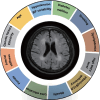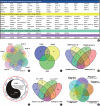Leukoaraiosis: Epidemiology, Imaging, Risk Factors, and Management of Age-Related Cerebral White Matter Hyperintensities
- PMID: 38836265
- PMCID: PMC11164597
- DOI: 10.5853/jos.2023.02719
Leukoaraiosis: Epidemiology, Imaging, Risk Factors, and Management of Age-Related Cerebral White Matter Hyperintensities
Abstract
Leukoaraiosis (LA) manifests as cerebral white matter hyperintensities on T2-weighted magnetic resonance imaging scans and corresponds to white matter lesions or abnormalities in brain tissue. Clinically, it is generally detected in the early 40s and is highly prevalent globally in individuals aged >60 years. From the imaging perspective, LA can present as several heterogeneous forms, including punctate and patchy lesions in deep or subcortical white matter; lesions with periventricular caps, a pencil-thin lining, and smooth halo; as well as irregular lesions, which are not always benign. Given its potential of having deleterious effects on normal brain function and the resulting increase in public health burden, considerable effort has been focused on investigating the associations between various risk factors and LA risk, and developing its associated clinical interventions. However, study results have been inconsistent, most likely due to potential differences in study designs, neuroimaging methods, and sample sizes as well as the inherent neuroimaging heterogeneity and multi-factorial nature of LA. In this article, we provided an overview of LA and summarized the current knowledge regarding its epidemiology, neuroimaging classification, pathological characteristics, risk factors, and potential intervention strategies.
Keywords: Genetic variants; Imaging; Leukoaraiosis; Risk factors; White matter hyperintensities; White matter lesions.
Conflict of interest statement
The authors have no financial conflicts of interest.
Figures




Similar articles
-
Genetic associations of leukoaraiosis indicate pathophysiological mechanisms in white matter lesions etiology.Rev Neurosci. 2015;26(3):343-58. doi: 10.1515/revneuro-2014-0082. Rev Neurosci. 2015. PMID: 25781674 Review.
-
[Association of diffusion tensor imaging abnormalities with executive dysfunction in patients with leukoaraiosis].Zhonghua Yi Xue Za Zhi. 2015 Dec 1;95(45):3650-4. Zhonghua Yi Xue Za Zhi. 2015. PMID: 26849925 Chinese.
-
Pathologic correlates of incidental MRI white matter signal hyperintensities.Neurology. 1993 Sep;43(9):1683-9. doi: 10.1212/wnl.43.9.1683. Neurology. 1993. PMID: 8414012
-
The spectrum of age-associated brain abnormalities: their measurement and histopathological correlates.J Neural Transm Suppl. 1998;53:31-9. doi: 10.1007/978-3-7091-6467-9_4. J Neural Transm Suppl. 1998. PMID: 9700644 Review.
-
Magnetic resonance imaging of the brain in patients with pseudoexfoliation syndrome and glaucoma.Ophthalmologica. 2006;220(2):125-30. doi: 10.1159/000090578. Ophthalmologica. 2006. PMID: 16491036
Cited by
-
Neuroprotective Effect of Rosuvastatin Calcium Combined with Hyperbaric Oxygen Mediated p38MAPK Pathway in Rats with Leukoaraiosis.Cell Biochem Biophys. 2025 Mar 22. doi: 10.1007/s12013-025-01702-9. Online ahead of print. Cell Biochem Biophys. 2025. PMID: 40119231
-
Blood biomarkers for vascular cognitive impairment based on neuronal function: a systematic review and meta-analysis.Front Neurol. 2025 Feb 7;16:1496711. doi: 10.3389/fneur.2025.1496711. eCollection 2025. Front Neurol. 2025. PMID: 39990267 Free PMC article. Review.
-
Association of white matter hyperintensity burden and infarct volume in the anterior choroidal artery territory with early neurological progression: a dual-center retrospective study.Front Aging Neurosci. 2025 May 19;17:1577742. doi: 10.3389/fnagi.2025.1577742. eCollection 2025. Front Aging Neurosci. 2025. PMID: 40458563 Free PMC article.
-
Deep and periventricular white matter hyperintensities exhibit differential metabolic profiles in arteriosclerotic cerebral small vessel disease: an untargeted metabolomics study.Front Neurosci. 2025 May 21;19:1607242. doi: 10.3389/fnins.2025.1607242. eCollection 2025. Front Neurosci. 2025. PMID: 40470292 Free PMC article.
-
Association between cerebral small vessel disease and malnutrition risk: a retrospective cross-sectional study.Front Neurol. 2025 Jun 18;16:1512109. doi: 10.3389/fneur.2025.1512109. eCollection 2025. Front Neurol. 2025. PMID: 40606134 Free PMC article.
References
-
- Hachinski VC, Potter P, Merskey H. Leuko-araiosis. Arch Neurol. 1987;44:21–23. - PubMed
-
- O’Sullivan M. Leukoaraiosis. Pract Neurol. 2008;8:26–38. - PubMed
-
- Hachinski VC, Potter P, Merskey H. Leuko-araiosis: an ancient term for a new problem. Can J Neurol Sci. 1986;13(4 Suppl):533–534. - PubMed
-
- Longstreth WT, Jr, Manolio TA, Arnold A, Burke GL, Bryan N, Jungreis CA, et al. Clinical correlates of white matter findings on cranial magnetic resonance imaging of 3301 elderly people. The cardiovascular health study. Stroke. 1996;27:1274–1282. - PubMed
Publication types
Grants and funding
LinkOut - more resources
Full Text Sources
Miscellaneous

